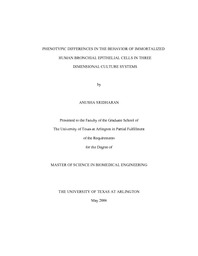
ATTENTION: The works hosted here are being migrated to a new repository that will consolidate resources, improve discoverability, and better show UTA's research impact on the global community. We will update authors as the migration progresses. Please see MavMatrix for more information.
Show simple item record
| dc.contributor.author | Sridharan, Anusha | en_US |
| dc.date.accessioned | 2007-08-23T01:56:49Z | |
| dc.date.available | 2007-08-23T01:56:49Z | |
| dc.date.issued | 2007-08-23T01:56:49Z | |
| dc.date.submitted | May 2006 | en_US |
| dc.identifier.other | DISS-1275 | en_US |
| dc.identifier.uri | http://hdl.handle.net/10106/466 | |
| dc.description.abstract | Human Bronchial Epithelial Cells (HBECS) immortalized with viral oncoproteins E6/E7, are potentially malignant due to numerous chromosomal aberrations. Recently a model system was established in which HBECS were immortalized with Cyclin-dependent-kinase-4 (Cdk4) and human Telomerase Reverse Transcriptase (hTERT). These cells were shown to have intact p53 checkpoints and had well expressed differentiation markers. HBECS are non-tumorigenic as they do not form tumors in nude mice or colonies in soft agar. The purpose of this research was to establish the differences in phenotypic behavior between HBECS immortalized with E6/E7 viral oncoproteins and HBECS immortalized with Cdk4/hTERT. A three dimensional culture model of a differentiated bronchial epithelium was constructed to study the differences between the HBECS immortalized by the two methods. The system consists of fibroblasts embedded in type I collagen matrix on which the HBECS are plated. The collagen gels are raised to an air-liquid interface and induced to differentiate for 21 days, in media conducive for differentiation. Pairs of HBECS immortalized using E6/E7 (with/without hTERT) or Cdk4/hTERT obtained from four different donors were tested. Normal lung fibroblasts from a 61 year old male, (61ML) or a 35 year old female, (35FL) were used to construct the stromal compartment. Another fibroblast cell line (FBL 15) isolated from the bronchial tumor of a 59 year old male was also used.
Results indicate that HBECS immortalized with E6/E7 viral oncoproteins exhibit an invasive phenotype regardless of culture conditions or fibroblasts used. The invasive behavior of HBECS immortalized with Cdk4/hTERT was fibroblast specific. The fibroblasts 61ML from aged donor were permissive to invasion of HBEC KTs unlike fibroblasts 35FL from a younger donor. Aging fibroblasts influence the invasive characteristics of HBECS, thereby implying a strong connection between aging and cancer. | en_US |
| dc.description.sponsorship | Minna, John | en_US |
| dc.language.iso | EN | en_US |
| dc.publisher | Biomedical Engineering | en_US |
| dc.title | Phenotypic Differences In The Behavior Of Immortalized Human Bronchial Epithelial Cells In Three Dimensional Culture Systems | en_US |
| dc.type | M.S. | en_US |
| dc.contributor.committeeChair | Minna, John | en_US |
| dc.degree.department | Biomedical Engineering | en_US |
| dc.degree.discipline | Biomedical Engineering | en_US |
| dc.degree.grantor | University of Texas at Arlington | en_US |
| dc.degree.level | masters | en_US |
| dc.degree.name | M.S. | en_US |
Files in this item
- Name:
- umi-uta-1275.pdf
- Size:
- 4.110Mb
- Format:
- PDF
This item appears in the following Collection(s)
Show simple item record


